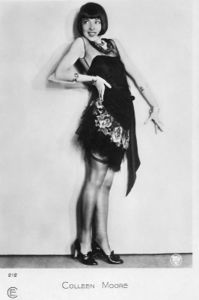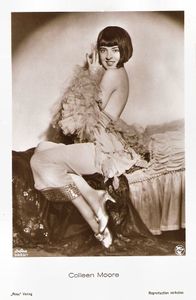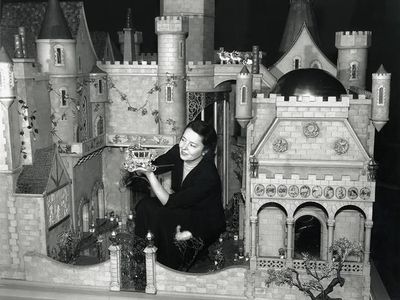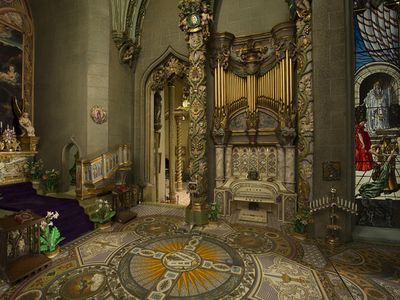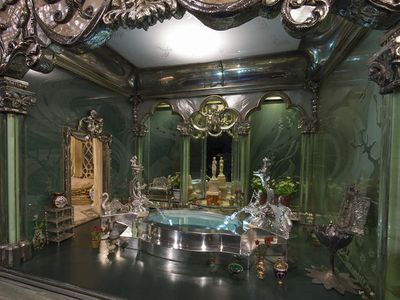Colleen Moore
We are still looking for more information on this actress |
Colleen Moore (born Kathleen Morrison; ✦August 19, 1899 – †January 25, 1988) was an American film actress who began her career during the silent film era. Moore became one of the most fashionable (and highly-paid) stars of the era and helped popularize the bobbed haircut.
Although Moore was a huge star in her day, approximately half of her films are now considered lost, including her first talking picture from 1929. What was perhaps her most celebrated film, Flaming Youth (1923), is now mostly lost as well, with only one reel surviving.
Moore took a hiatus from acting between 1929 and 1933, just as sound was being added to motion pictures. After she returned, her four sound pictures released in 1933 and 1934 were not financial successes. She then retired permanently from screen acting.
After her film career, Moore maintained her wealth through astute investments, becoming a partner of Merrill Lynch. She later wrote a "how-to" book about investing in the stock market.
Moore also nurtured a passion for dollhouses throughout her life and helped design and curate The Colleen Moore Dollhouse, which has been a featured exhibit at the Museum of Science and Industry in Chicago(see Colleen Moore's "Fantasy Doll House below) since the early 1950s. The dollhouse, measuring 9 square feet (0.84 m2), was estimated in 1985 to be worth $7 million, and it is seen by 1.5 million people annually.
Early life
Moore was born Kathleen Morrison on August 19, 1899, (according to the bulk of the official records; the date which she insisted was correct in her autobiography, "Silent Star", was 1902) in Port Huron, Michigan, Moore was the eldest child of Charles R. and Agnes Kelly Morrison. The family remained in Port Huron during the early years of Moore's life, at first living with her grandmother Mary Kelly (often spelled Kelley) and then with at least one of Moore's aunts.
By 1905, the family moved to Hillsdale, Michigan, where they remained for over two years. They relocated to Atlanta, Georgia, by 1908. They are listed at three different addresses during their stay in Atlanta. They then lived briefly — probably for less than a year — in Warren, Pennsylvania, and by 1911, they had settled in Tampa, Florida.[8]
At the age of 15 she took her first step into Hollywood. Her uncle arranged a screen test with director D. W. Griffith. She wanted to be a second Lillian Gish but instead, she found herself playing heroines in Westerns with stars such as Tom Mix.
Two of Moore's great passions were dolls and movies; each would play a great role in her later life. She and her brother began their own stock company, reputedly performing on a stage created from a piano packing crate. Her aunts, who doted on her, indulged her other great passion and often bought her miniature furniture on their many trips, with which she furnished the first of a succession of dollhouses. Moore's family summered in Chicago, where she enjoyed baseball and the company of her Aunt Lib (Elizabeth, who changed her name to "Liberty", Lib for short) and Lib's husband Walter Howey. Howey was the managing editor of the Chicago Examiner and an important newspaper editor in the publishing empire of William Randolph Hearst, and was the inspiration for Walter Burns, the fictional Chicago newspaper editor in the play and the film The Front Page.
Career
Early years Essanay Studios was within walking distance of the Northwestern L (elevated train), which ran right past the Howey residence. (They occupied at least two residences between 1910 and 1916: 4161 Sheridan and 4942 Sheridan.) In interviews later in her silent film career, Moore claimed she had appeared in the background of several Essanay films, usually as a face in a crowd. One story has it that she got into the Essanay studios and waited in line to be an extra with Helen Ferguson: in an interview with Kevin Brownlow many years later, Ferguson told a story that substantially confirmed many details of the claim, though it is not certain whether she was referring to Moore's stints as a background extra (if she really was one) or to her film test there prior to her departure for Hollywood in November 1917. Film producer D. W. Griffith was in debt to Howey, who had helped him to get both The Birth of a Nation and Intolerance through the Chicago censorship board.
- "I was being sent to Hollywood - not because anybody out there thought I was any good, but simply to pay off a favor".
The contract to Griffith's Triangle-Fine Arts was conditional on passing a film test to ensure that her heterochromia (she had one brown eye, one blue eye) would not be a distraction in close-up shots. Her eyes passed the test, so she left for Hollywood with her grandmother and her mother as chaperones. Moore made her first credited film appearance in 1917 in The Bad Boy for Triangle Fine Arts, and for the next few years appeared in small, supporting roles gradually attracting the attention of the public.
The Bad Boy was released on February 18, and featured Robert Harron, Richard Cummings, Josephine Crowell, and Mildred Harris (who would later become Charles Chaplin's first wife). Two months later, it was followed by An Old-Fashioned Young Man, again with Robert Harron. Moore's third film was Hands Up! filmed in part in the vicinity of the Seven Oaks (a popular location for productions that required dramatic vistas). This was her first true western. The film's scenario was written by Wilfred Lucas from a story by Al Jennings, the famous outlaw who had been freed from jail by presidential pardon by Theodore Roosevelt in 1907. Monte Blue was in the cast and noticed Moore could not mount her horse, though horseback riding was required for the part (during casting for the part she neglected to mention she did not know how to ride). Blue gave her a quick lesson essentially consisting of how to mount the horse and how to hold on.
On May 3, 1917, the Chicago Daily Tribune said:
- "Colleen Moore contributes some remarkable bits of acting. She is very sweet as she goes trustingly to her bandit hero, and, O, so pitiful, when finally realizing the character of the man, she goes into a hysteria of terror, and, shrieking 'Daddy, Daddy, Daddy!' beats futilely on a bolted door, a panic-stricken little human animal, who had not known before that there was aught but kindness in the world." About the time her first six-month contract was extended an additional six months, she requested and received five weeks' release to do a film for Universal's Bluebird division, released under the name The Savage. This was her fourth film, and she was only needed for two weeks. Upon her return to the Fine Arts lot, she spent several weeks trying to get her pay for the three weeks she had been available for work for Triangle (finally receiving it in December of that year).
</gallery>
- More information is available at [ Wikipedia:Colleen_Moore ]
Colleen Moore's "Fantasy Doll House
Source
- Pinterest (or -- )
External links
- Colleen Moore's Fairy Castle, at the Museum of Science and Industry, Chicago
- MSI article on Doll House
- Google search for Fantasy Castle
Chat rooms • What links here • Copyright info • Contact information • Category:Root
